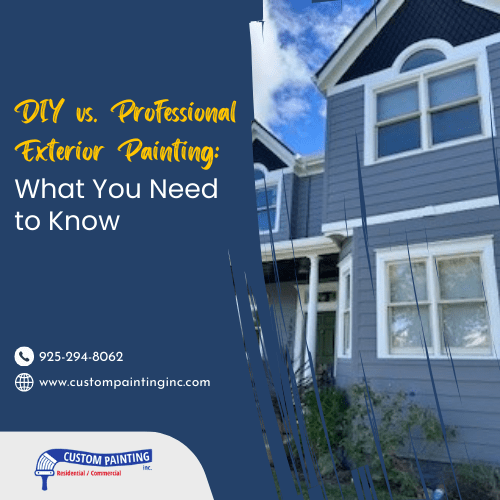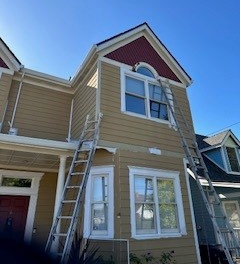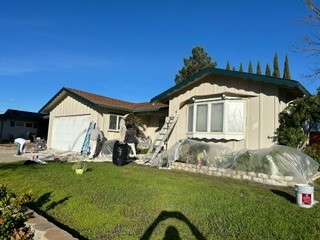Painting the exterior of your Concord home is a big job. It’s about making it look good and protecting it from the weather. Some people like to do this job themselves, while others prefer to hire professionals like Custom Painting, Inc. In this article, we will talk about everything you need to know before you decide to paint your house alone or get someone else to do it.
We’ll cover how to get your house ready, what steps to follow to paint it, the challenges you might face, and some tips to do it right. Whether you’re considering grabbing a paintbrush or hiring a team to help, we’ve got you covered.
Homeowner’s Responsibilities Before Exterior Painting
When you choose to give your Benicia home’s exterior a fresh coat of paint, whether tackling the project yourself or bringing in a professional team, you should take several key steps to ensure the process goes smoothly. Preparing for exterior painting isn’t just about picking the right color; it involves a series of responsibilities to ensure the surface is ready and that the project can proceed without any hitches. Here’s what homeowners should keep in mind:
- Garden Maintenance: Before any painting can begin, it’s crucial to clear the area around your house. This means trimming back bushes, trees, and any other vegetation that might obstruct access to your home’s walls. Not only does this make it easier to paint, but it also helps prevent plants from getting damaged during the process.
- Water Control: To ensure the painting area remains dry, homeowners should turn off sprinkler systems well before the painting schedule. Wet surfaces can significantly delay the project and affect the quality of the paint job.
- Pet Management: Pets can be curious and may wander into the work area, posing risks to themselves and disrupting the project. Homeowners should plan to keep pets indoors or in a secured location away from the painting activities. Additionally, cleaning up after pets in the yard is important to avoid any unpleasant surprises for the painting crew.
Avoiding DIY Surface Preparations for Professional Projects
When hiring a professional painting company in the Pleasant Hillarea, homeowners should refrain from undertaking major surface preparation tasks. This is important for several reasons:
- Warranty Issues: Many painting companies offer warranties for their work. However, these warranties might be voided if the homeowner has done part of the preparation work. This is because improper preparation can lead to paint failure, and the company would not want to be held responsible for work they did not oversee or approve.
- Professional Standards: Professional painters have the experience and knowledge to properly prepare surfaces for painting, ensuring that the paint will adhere well and last longer. They know how to deal with various materials and conditions that a typical homeowner might not know.
While homeowners have important roles in preparing their property for an exterior paint job, they should leave the technical aspects of surface preparation to the professionals when hiring a company. This ensures that the project is completed efficiently, safely, and to a standard that the homeowner and the professionals can be proud of.
Steps in Preparing House Exterior for Painting
Preparing the exterior of your Vallejo area home for painting is crucial for a successful paint job. This preparation ensures the paint adheres properly, lasts longer, and looks great. Here are the key steps you should follow:
- Assessment of the House Exterior: Start by looking at your house’s exterior to understand the extent of the work required. Check for any signs of damage, peeling paint, mold, or mildew. This will help you identify what repairs are needed and the type of materials and tools you’ll need.
- Gathering Tools and Materials: Collect all the necessary tools and materials before you start. This includes ladders, brushes, rollers, scrapers, sandpaper, primer, paint, and safety gear. Having everything on hand will make the process smoother and faster.
- Cleaning the Surface: A clean surface is key for paint to adhere properly. Use a power washer or a hose with a cleaning solution to remove dirt, grime, and mildew from the walls. Allow the surface to dry completely before moving on to the next step.
- Making Repairs: Address any issues you discovered during your assessment. Fill cracks and holes with caulk or a suitable filler. Replace or repair damaged wood or siding. Ensuring the surface is in good condition before painting is essential for a lasting finish.
- Sanding: Sanding smooths the surface and removes old, peeling paint. It’s an important step for achieving a smooth, professional-looking finish. Use sandpaper or a sanding block to lightly sand the surface, focusing on rough areas and edges.
- Priming: Primer serves as a base for the paint, improving its adhesion and longevity. Apply a quality exterior primer, especially on new surfaces or areas where you’ve made repairs. Let the primer dry as recommended by the manufacturer.
- Covering Areas: Protect windows, doors, and landscaping from paint drips and overspray. Use painter’s tape, plastic sheeting, or drop cloths to cover these areas. This step saves time on cleanup and prevents damage to your property.
- Choosing Paint: Selecting the right paint is critical. Consider the climate, the surface material of your home, and the durability of different paint types. Also, think about the finish and color you want. High-quality exterior paint can withstand the elements better and last longer.
Following these steps ensures your house is well-prepared for painting, leading to a more durable and aesthetically pleasing result. Whether tackling the project yourself or hiring professionals, proper preparation is the foundation of a great exterior paint job.
Challenges of Exterior Painting
Exterior painting is not without its challenges. Understanding these obstacles can help homeowners prepare better and make informed decisions, whether undertaking the project themselves or hiring professionals in Benicia. Here are some common challenges faced during exterior painting:
- Unpredictable Weather: The biggest challenge with exterior painting is the weather. Rain, high humidity, and extreme temperatures can ruin a fresh coat of paint. Planning your painting project around the weather forecast is crucial, but unexpected changes can still disrupt your plans.
- Temperature Fluctuations: Paint needs time to dry and cure properly. Too hot or cold temperatures can prevent paint from setting correctly, leading to issues like peeling or cracking over time.
- Working at Heights: Exterior painting often requires working on ladders or scaffolding to reach high areas. This poses a risk of falls and injuries, especially for those not experienced in working at heights.
- Chemical Exposure: Paints and solvents contain chemicals that can be harmful if not handled properly. Using appropriate safety gear and ventilation is essential to minimize health risks.
- Preparation and Execution Time: A significant amount of time is needed to prepare the surface, apply multiple coats, and wait for the paint to dry. Underestimating the time required for a quality job can lead to rushed work or unfinished projects.
- Balancing Personal Commitments: For DIY enthusiasts, finding the time for an exterior painting project amid personal and professional commitments can be challenging. Projects often take longer than anticipated, further complicating time management.
- Skill Level: Exterior painting is not just about applying paint. Achieving a smooth, even coat without drips or streaks requires skill and practice. Novices may find it challenging to achieve professional-quality results.
- Color Consistency: Ensuring consistent color coverage across the entire exterior can be difficult, especially for larger homes or those with intricate architectural details.
- Choosing the Right Tools and Materials: The quality of tools and paint can significantly affect the outcome. Knowing which brushes, rollers and types of paint to use for different surfaces and weather conditions requires research and expertise.
- Cost of High-Quality Materials: High-quality paints and equipment are more expensive but necessary for durability and finish. Balancing cost without compromising quality is challenging for those on a tight budget.
Understanding these challenges can help homeowners plan their exterior painting projects more effectively. Whether deciding to DIY or hire professionals, being aware of potential obstacles allows for better preparation, realistic timelines, and a successful painting project.
Best Practices in Exterior Painting
A successful exterior painting project not only enhances the visual appeal of your home but also protects against the elements. Adhering to best practices ensures that your painting efforts yield the best results, with a finish that lasts for years. Here are some key best practices to follow:
- Invest in High-Quality Paint: While it might be tempting to save money on cheaper options, high-quality paint provides better coverage, durability, and resistance to weather conditions. It can also save you money in the long run by reducing the frequency of repainting.
- Use the Right Tools: Quality brushes, rollers, and sprayers significantly affect the application process and the final look. Invest in the best tools you can afford for a smoother, more professional finish.
- Clean Thoroughly: A clean surface is crucial for ensuring paint adhesion. Power washing to remove dirt, grime, and mildew is a vital step that shouldn’t be skipped.
- Repair and Prime: Before painting, address surface imperfections, such as cracks or peeling paint. Apply a quality primer to ensure a solid foundation for the topcoat.
- Paint in the Right Conditions: Avoid painting in extreme temperatures or when rain is expected. Ideal painting conditions are dry, with mild temperatures and low humidity.
- Plan According to the Weather: Monitor the weather forecast and plan your painting schedule to avoid adverse conditions that could affect paint application and drying.
- Seek Professional Advice: Even if you plan to DIY, consulting with a professional painter can provide valuable insights into color choices, techniques, and potential issues specific to your home’s exterior.
- Consider Hiring Professionals: For large-scale projects and intricate designs, or if you lack the time or confidence to do something DIY, hiring professional painters might be the best option. They bring expertise, efficiency, and equipment to the project, ensuring high-quality results.
- Regular Maintenance: Extend the life of your paint job with periodic cleaning and touch-ups. Inspect your home’s exterior annually and address any issues promptly to prevent major repairs later.
Following these best practices in exterior painting can significantly impact the quality and longevity of your paint job. Whether you decide to take on the project yourself or hire professionals, preparation, patience, and attention to detail are key to achieving a beautiful and durable finish.
DIY vs. Professional – Making the Decision
Deciding between a DIY approach and hiring professionals for your exterior painting project involves weighing several factors. Each option has benefits and challenges; the right choice depends on individual circumstances, skills, and preferences. Here’s how to make an informed decision:
- DIY Cost Savings: The most apparent advantage of DIY painting is the potential savings on labor costs. However, remember to account for the expenses of materials, tools, and any necessary equipment rentals.
- Professional Costs: Hiring professionals involves labor costs, which can be significant. However, professionals often have access to higher-quality materials at lower prices due to their relationships with suppliers, which can offset some costs.
- DIY Skills Assessment: Honestly assess your painting skills and the quality level you can achieve. Exterior painting requires more than just the ability to apply paint; knowledge of surface preparation, repair, and safety measures is also crucial.
- Professional Quality: Professional painters bring experience and expertise to the table, ensuring a high-quality finish. They know how to handle challenges and achieve consistent, high-quality results faster than the average homeowner.
- DIY Time Commitment: A DIY project can be time-consuming, from planning and preparation to painting and cleanup. Consider whether you have the time to dedicate to the project and the impact on your daily life.
- Professional Efficiency: Hiring professionals can significantly reduce the time your home is under renovation. They have the skills, team, and equipment to do the job efficiently, minimizing disruption to your routine.
- DIY Project Scope: Small to medium-sized projects might be manageable for a DIY approach, especially if you have previous painting experience and are not under a tight deadline.
- Professional for Large Projects: For large homes, complex architectures, or when high areas are involved, professional painters are better equipped to handle the scale and safety requirements of the job.
- DIY Satisfaction: For many, the satisfaction of completing a home improvement project themselves is a significant factor. DIY projects can offer a sense of achievement and the opportunity to learn new skills.
- Professional Peace of Mind: Hiring professionals can provide peace of mind, knowing that the project is in the hands of experts. It allows homeowners to focus on other aspects of their lives without the stress of a large project.
- DIY Risks: DIY projects come with the risk of mistakes that can be costly to rectify. Additionally, your insurance might not cover personal injuries or damage to your property.
- Professional Coverage: Reputable professional painters are insured, reducing liability on your part. They may also offer warranties on their work, ensuring any issues are corrected without additional cost.
Deciding between DIY and professional exterior painting comes down to evaluating your skills, budget, time availability, and the quality you aim to achieve. Consider all factors carefully to make a choice that aligns with your expectations, budget, and lifestyle.
Conclusion
In conclusion, whether you paint your home’s exterior yourself or hire professionals, the most important thing is ensuring the job is done right. Take the time to consider your options, evaluate your skills and budget, and choose the path that best suits your needs and ensures a beautiful, long-lasting finish for your home.
If you want professional help or need expert advice, don’t hesitate to contact Custom Painting, Inc. You can reach us at 925-686-0903 or use our online contact form to send a message. We’re here to help make your exterior painting project a success!





